Comprehensive Canon Camera Reviews for Every Photographer
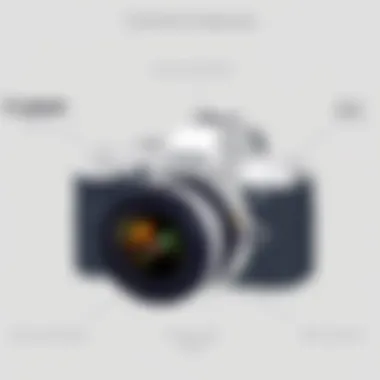
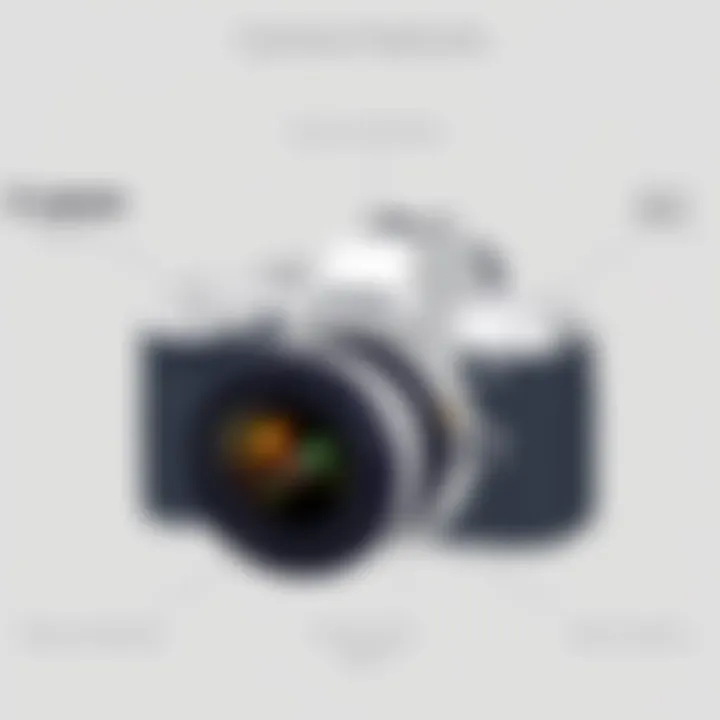
Intro
Diving into the world of photography often feels like navigating a labyrinth of choices, especially when it comes to selecting a camera. In a landscape flooded with options, Canon stands out with a reputation that photography enthusiasts respect. Known for its innovation and user-friendly designs, Canon continually refines its offerings to cater to a diverse range of users. This article will illuminate the unique advantages and possible drawbacks of Canon cameras, helping both seasoned professionals and enthusiastic hobbyists make informed decisions.
With technology evolving at a breakneck pace, understanding the nuances of each Canon model can shape the experience you have behind the lens. Whether you're a budding photographer hoping to capture memories or a seasoned pro looking for equipment that can withstand the demands of commercial work, Canon has something to offer. As we peel back the layers of specifications and features, we aim to highlight what makes these cameras tick and whether they meet modern needs.
We will take a meticulous look at various Canon models, examining their standout characteristics, strengths, and weaknesses. By the end of this assessment, you will have a clearer understanding of how these cameras may serve your individual photography pursuits. Each model will be scrutinized, weighing real-world performance against technical specifications, ensuring a well-rounded perspective.
From entry-level to advanced models, this overview intends to serve as a comprehensive guide to better equip you in your choices, maintaining relevance amidst fierce competition from other brands. Ready your notepad, because we are about to dive into the essential features of Canon's offerings.
Preface to Canon Cameras
Understanding Canon cameras is not just a matter of knowing how to take a good picture. It’s about diving into a world of technological evolution and artistic expression. Canon, established in the 1930s, has consistently been at the forefront of camera innovation, which is a testament to its robust engineering and commitment to quality. For both professionals and enthusiasts, the choice of a camera can significantly affect the outcome of their photography journey, and Canon has made its mark as a trusted brand in this domain.
History and Evolution of Canon
Canon’s journey began in 1937, with the release of the Kwanon, Japan’s first 35mm focal-plane shutter camera. This marked the outset of a long-standing tradition filled with evolution and advancement. Canon continuously adapted through various technological shifts in the photography landscape, setting itself apart by harnessing innovation to meet users’ needs. For instance, the introduction of the Canon EOS system in 1987 revolutionized autofocus technology, making it easier for photographers to capture sharp images quickly. Through the years, Canon has embraced the digital transformation, implementing sensor technology that enhances image quality and produces vibrant colors. It's like watching a child grow into an adult—each phase shapes who they become, and Canon, too, has matured with time, always striving to push the envelope.
Caring for consumer preferences, Canon has also expanded its product range across multiple camera categories. From DSLR to mirrorless options, each product reflects the company’s devotion to photography. The aggressive incorporation of video capabilities is another chapter in this story that cannot be overlooked, as today’s creators demand versatility from their gear.
The Canon Brand and Its Reputation
When discussing camera brands, Canon stands neck and neck with the giants. The brand has built a reputation that resonates with trust and reliability among users. Many photography enthusiasts regard the name Canon synonymous with quality, which isn’t just a fluke or a matter of marketing spin. Customer satisfaction is high, largely due to the performance and durability of Canon products.
Moreover, Canon nurtures a vibrant community of users. Online forums buzzing with discussions allow newcomers to connect with veteran photographers, exchanging tips on utilizing their rigs. It is indeed a camaraderie that elevates their experience.
Canon's dedication doesn't only end with the cameras; the company invests in user education and workshops, enhancing the overall photography skills of its customer base. Additionally, the brand has consistently garnered positive reviews across its product lines, often praised for exceptional autofocus systems and color reproduction.
"Canon's legacy in imaging technology has shaped the way photographers capture the world, a legacy not easily overlooked."
In summary, Canon's long history and the solid reputation it has cultivated over decades position it as a dominant player in the market. Their commitment to innovation and customer satisfaction assures photographers they are choosing equipment designed to enhance their skills and creative expression.
Types of Canon Cameras
Understanding the different types of Canon cameras is crucial for anyone looking to make an informed choice in today’s crowded photography market. Canon offers a wide range of camera options that cater to diverse needs and preferences, from seasoned professionals to casual hobbyists. Here, we will explore these various types, highlighting their unique characteristics, benefits, and the considerations to take into account when selecting a camera that fits your style and requirements.
DSLR Cameras Overview
Digital Single Lens Reflex cameras have long been the backbone of photography. Canon’s DSLR lineup is known for its rich history and robust performance. Notably, DSLRs utilize a mirror mechanism that allows photographers to see exactly what the lens sees. This traditional design offers a few advantages:
- Optical Viewfinder: Photographers benefit from a direct view through the lens via an optical viewfinder, which reduces lag and offers a true-to-life perspective.
- Battery Life: Generally, DSLRs tend to excel in battery life due to less power consumption when not using live view.
- Variety of Lenses: Canon’s rich ecosystem of EF lenses expands creative possibilities significantly.
However, it’s important to acknowledge that DSLRs can be bulkier than their mirrorless counterparts, which might be a deal-breaker for some users. Nonetheless, for those who prioritize tactile controls, durability, and an extensive lens selection, DSLRs continue to hold their ground impressively.
Mirrorless Camera Innovations
The advent of mirrorless technology marks a significant shift in the camera landscape. Canon has embraced this trend wholeheartedly, producing models that cater to both entry-level users and professionals alike. What sets mirrorless cameras apart is their omission of the mirror mechanism, which contributes to a lighter design and more compact form factor. Here are a few aspects worth noting:
- Faster Shooting Speeds: Without the mechanical mirror, these cameras often have quicker continuous shooting rates, making them ideal for capturing fast-moving subjects.
- Real-Time Exposure Preview: The electronic viewfinders (EVFs) provide an instant preview of exposure settings, allowing for precise adjustments before taking a shot.
- Advanced Video Features: Canon’s mirrorless offerings have become particularly popular among videographers due to their enhanced video capabilities, often supporting high resolutions and frame rates.
However, the battery life can be less impressive given the power demands of electronic displays, making it crucial for users to consider their shooting habits when opting for a mirrorless system.
Compact and Point-and-Shoot Options
For those who value convenience and ease of use, Canon's compact and point-and-shoot cameras represent a compelling choice. These cameras are designed for novice photographers or anyone who prefers a lightweight, hassle-free device. The advantages of this category include:
- Portability: Small enough to fit in a pocket, these cameras are perfect for travel and spontaneous photography.
- User-Friendly Interfaces: Built with simplicity in mind, they offer straightforward menus and automatic settings that allow users to focus on capturing moments rather than tweaking complex settings.
- Affordability: Generally, these cameras come at a lower price point relative to DSLRs and mirrorless options, making them accessible for a wider audience.
Still, the limitations in manual control and the often smaller sensor sizes compared to higher-end models might deter those who are serious about photography. Finding a balance between convenience and capability will be key for potential buyers.
"Selecting the right camera is about identifying your needs, budget, and long-term photography goals. Each type of Canon camera has its own set of strengths but also drawbacks that might not suit your style."
In summary, each type of Canon camera offers distinct features that cater to various segments of the photography market. Understanding these differences not only helps you choose wisely but also enriches your overall photographic experiences.
Canon Entry-Level DSLRs
Entry-level DSLRs are a significant segment in Canon's camera lineup. They open the door for novice photographers to step into the world of interchangeable lens cameras. The ease of use, combined with advanced features, makes these models appealing for individuals wanting to learn photography without overwhelming complexity. They stand as a bridge between compact cameras and more advanced models, allowing users to explore their creativity and technical skills.
\n
Canon EOS Rebel Series
Features and Benefits
The Canon EOS Rebel series is often considered the quintessential starting point for budding photographers. One standout feature is its intuitive interface that simplifies complex settings. This aspect is crucial because it allows beginners to grasp the basics of exposure, aperture, and shutter speed without feeling lost. Notably, the Rebel models come equipped with a variety of scene modes, which automatically adjust settings based on the shooting environment. This characteristic not only elevates image quality but also boosts confidence for new users.
A unique selling point of the Rebel series is its compatibility with a wide range of affordable lenses, allowing users to upgrade and expand their capabilities as they grow in skill. However, while these cameras are versatile, one should consider that they may lack some advanced features found in higher-end models that professionals might expect. In this article, we emphasize that the reliability and ease of use make the Rebel series a wise choice for entry-level enthusiasts looking to enhance their photographic knowledge.
\n


Target Audience and Use Cases
The target audience for the EOS Rebel series is primarily aspiring photographers and hobbyists. These users fall into various categories—students, travelers, and families looking to capture memorable moments in an accessible format. The versatility of the Rebel systems makes them a fitting choice for diverse photography styles, ranging from portraits to landscapes. Notably, they are also ideal for educational environments where learning the principles of photography is essential.
In terms of practical applications, families often find themselves delighted with the quality of images they can produce, surpassing that of conventional point-and-shoot cameras. The ability to change lenses expands creative options significantly, appealing to those who want to experiment without splurging on high-end gear. Still, potential buyers should be aware that the features aimed at beginners may underperform in highly demanding environments, such as low-light situations.
\n
Performance and Image Quality
When it comes to performance, entry-level Canon DSLRs deliver solid results that are often surprising for their price point. The autofocus systems, while not as fast or sophisticated as those found in professional-grade cameras, are generally reliable. The image quality produced is typically characterized by rich colors and good detail retention, even at higher ISO settings.
One cannot overlook the learning curve these cameras present. While they provide essential features to aid learning, enthusiastic users might crave more advanced performance as they progress. However, this aspect also means that many will continue to use their Rebel cameras longer, growing into the tools at their disposal.
The Canon EOS Rebel series empowers users with an accessible pathway to explore photography, blending performance with simplicity, ensuring that even the most novice user can thrive.
Mid-Range DSLR Options
When discussing Canon cameras, mid-range DSLRs hold a significant place. They serve as a bridge between entry-level models, like the Canon EOS Rebel series, and the high-end professional variants. This segment caters to both enthusiasts who seek greater control and functionality without the complexities of advanced models, and semi-professional photographers looking to upgrade. Mid-range options typically offer a solid balance of performance, features, and price, making them highly desirable for a wide array of users.
Canon EOS 90D Analysis
Core Specifications
The Canon EOS 90D distinguishes itself in this competitive mid-range field with its impressive specifications. Boasting a 32.5-megapixel APS-C sensor, it captures images with remarkable detail and clarity. Not only does this enhance print quality, but it also ensures vibrant colors and superb dynamic range. The camera supports continuous shooting at 10 frames per second, making it ideal for action photography. This combination of features caters well to those who demand performance without needing to break the bank.
A standout point is the Dual Pixel CMOS autofocus system that enables fast and accurate focusing, particularly in live view mode. This is especially beneficial for video enthusiasts, as it smoothly transitions between subjects during recording. However, despite its myriad advantages, the EOS 90D can be somewhat bulky, which may deter users preferring more compact solutions. Overall, its strong capabilities solidify the 90D's position as a popular choice within this category.
Comparative Performance
In terms of comparative performance, the EOS 90D stacks up well against competitors like the Nikon D7500 and Sony A6400. Notably, the 90D stands out due to its higher pixel count, which gives it an edge in capturing fine details. Moreover, its robust build quality and weather sealing add an extra layer of durability, essential for outdoor shooting.
Each competitor has its unique strengths; for example, the D7500 may provide slightly better low-light performance, while the A6400 is often favored by those who prioritize portability. Still, the EOS 90D's versatility and comprehensive feature set, such as a fully articulating touchscreen, make it a compelling option for many photographers, particularly those who value responsiveness in fast-paced shooting environments.
User Experience and Reviews
User experiences with the Canon EOS 90D paint a positive picture. Many reviews highlight its intuitive layout, which allows both seasoned photographers and newcomers to navigate settings with ease. Feedback from users on various online platforms, such as reddit.com, showcases appreciation for its customizable functions.
While there are praises, some reviews mention the weight of the camera as a downside, especially for those who plan on long shoots without a tripod. Furthermore, the battery life, although praised, could be improved to cater to extended use. Yet, the overall sentiment remains that the Canon EOS 90D provides a robust solution for those seeking mid-range performance. Its blend of features and solid build caters effectively to aspiring professionals and fervent hobbyists alike.
High-End and Professional Models
High-end and professional cameras from Canon represent the pinnacle of photographic technology. These models aren't just about having a high price tag; they incorporate advanced features, robust build quality, and superior image performance that attract serious photographers. They play a critical role in the landscape of professional photography, where reliability and image quality can make or break a project. For enthusiasts and professionals alike, understanding these models opens up a world of possibilities, whether it's shooting sports, weddings, or nature photography.
Canon EOS-1D Mark Examination
The Canon EOS-1D X Mark III stands out as a premier choice for professional photographers who demand nothing less than excellence. This camera is built for speed and performance, making it a solid player in news, sports, and wildlife photography. Its autofocus system is particularly noteworthy, featuring impressive tracking capabilities that are essential for capturing fast-moving subjects.
In-Depth Performance Analysis
Diving into performance, the EOS-1D X Mark III boasts a 20.1 MP full-frame sensor that is designed to excel in low-light scenarios. This high sensitivity enables users to shoot in challenging environments without losing detail. Additionally, the camera supports continuous shooting at 20 frames per second when using the electronic shutter, essential for action shots. The sophisticated Dual Pixel CMOS AF system ensures fast and precise focusing, even under dynamic conditions.
A key characteristic of the EOS-1D X Mark III is its durability. The body is designed to withstand tough conditions, often sought after in fields like photojournalism where exposure to elements is an inevitable part of the job. While this robustness can make it slightly heavier, the trade-off is well worth it for serious shooters who require gear that can endure.
"The EOS-1D X Mark III is the kind of camera that delivers results you can bet your reputation on."
Industry Use Cases
When discussing industry use cases, the EOS-1D X Mark III shines in its adaptability across different fields. Sports photographers love this model for its high frame rate and excellent autofocus system, enabling them to capture key moments during fast-paced events.
In the realm of wildlife photography, professionals appreciate how its responsive shooting helps in capturing fleeting moments that might be otherwise missed. The lens system compatibility also allows wildlife photographers to utilize Canon's high-performance L-series lenses, enhancing the clarity and sharpness of images.
However, while the camera's features and durability cater to professional needs, the price point can be a barrier for hobbyists or those just starting in photography. This is a consideration that potential buyers must weigh against their particular needs and budget. The unique build and feature set of the EOS-1D X Mark III indeed justifies the investment for serious professionals.
Comparison with Competitors
In comparison with industry rivals like Nikon and Sony, the Canon EOS-1D X Mark III holds its ground, particularly in autofocus capabilities and overall shooting performance. Nikon's D6 is often highlighted as a close competitor, featuring a similar price point and robust offerings, yet some photographers prefer Canon's user interface and color science.
Sony brings a different approach with their A9 II, which excels in electronic viewfinder technology and silent operation, attracting those who shoot discreetly. However, styling and handling preferences can make Canon’s options more appealing to certain users. All in all, understanding these comparisons helps inform choices and allows photographers to select a model that best fits their specific shooting style.
While Canon's high-end offerings are undeniably some of the best on the market, potential buyers are encouraged to examine their unique needs, considering factors beyond just specifications—to ensure they select the model that aligns most closely with their photographic journey.
Mirrorless Camera Landscape
The rise of mirrorless cameras has dramatically reshaped the landscape of photography over the last decade. They offer an innovative blend of technology and flexibility that captured the attention of both seasoned photographers and enthusiastic newcomers. In this section, we delve into the significance of mirrorless systems within Canon's offerings, examining the unique advantages they provide, as well as considerations that prospective buyers should keep in mind.
Canon EOS R and RP Insights
The Canon EOS R and RP are flagship models that boldly illustrate the brand's commitment to evolving in the face of changing photography needs. These models leverage cutting-edge technology, streamlining the user experience while maintaining signature Canon quality. The EOS R, showcasing a full-frame sensor, offers robust performance with advanced autofocus capabilities. This is essential for capturing dynamic, fast-paced subjects, which is a game changer for sports or wildlife photography.
On the other hand, the EOS RP is a more approachable option, boasting many of the same features, but at a lower price point. It retains the impressive image quality found in its big brother while reducing size and weight. Notably, both models support Canon’s RF lens line, which expands their versatility and utility.
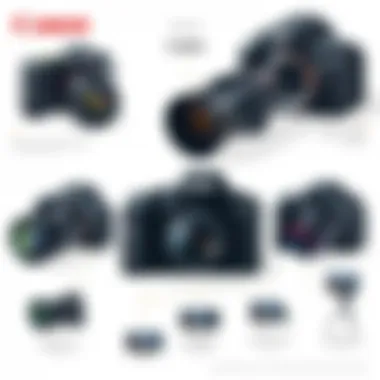
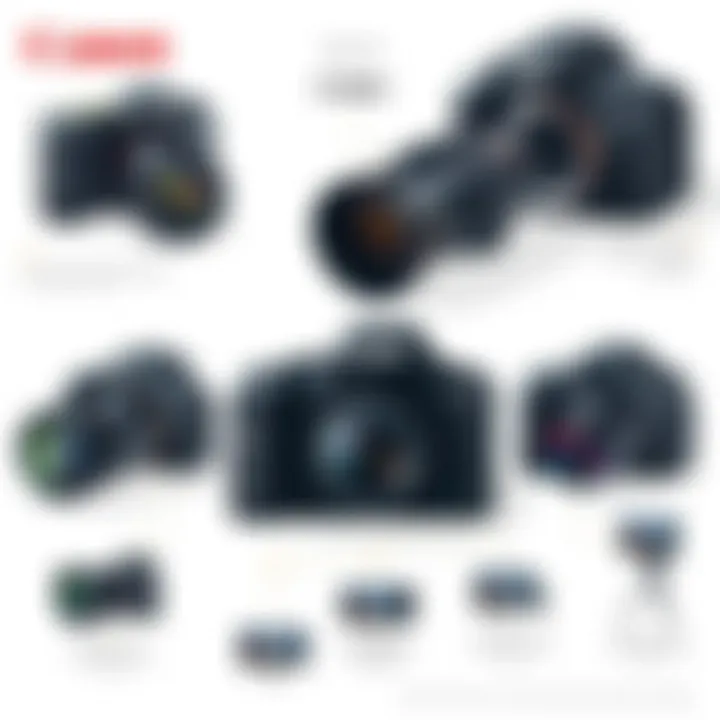
The innovation in these cameras signals Canon's recognition of the mirrorless trend, making it clear that they're not just catching up but leading the charge in several aspects of design and performance.
Advantages of Canon's Mirrorless Systems
Adaptability with EF Lenses
One standout characteristic of Canon's mirrorless lineup is their adaptability with existing EF lenses. This is quite significant for Canon users, as many photographers already have an established lens collection from their DSLR systems. The adaptability allows for a smooth transition for those who are used to traditional DSLRs, facilitating an upgrade without losing their investment in lenses. This competitive edge fosters a broader acceptance among users hesitant to switch brands due to lens compatibility concerns.
Moreover, Canon provides an adapter that ensures full functionality with EF and EF-S lenses, including image stabilization and autofocus. This flexibility not only simplifies the gear transition but also enhances the shooting experience by retaining the range of creative options offered by EF lenses. However, it's worth noting that while the adaptability is a massive plus, such adapters can sometimes add extra bulk and weight, which might be a drawback for those seeking lightweight setups.
Video Capabilities
The video capabilities of Canon's mirrorless systems are also notable, particularly as content creation expands beyond traditional photography. These cameras are engineered to support high-quality video recording up to 4K resolution, which has rapidly become a standard for serious videographers.
The EOS R, for instance, offers features like Dual Pixel autofocus during video recording, ensuring sharp focus transitions, which is crucial when capturing dynamic scenes. Furthermore, the inclusion of an external microphone input and headphone jack means that users can achieve professional results right out of the box.
However, some users note that 4K video can come with a crop factor, which may limit the wide-angle options available. Still, the overall video performance remains a strong point for those looking to delve into hybrid shooting without needing multiple cameras for stills and motion.
"The transition to mirrorless isn’t just about lighter bodies or more features; it’s also about how these systems change the way we think about photography."
In summary, Canon’s mirrorless offerings illustrate a thoughtful approach to modern photography needs while embracing traditional strengths. These systems blend advanced technology with established user preferences, allowing Canon to maintain its robust reputation in a competitive market.
Point-and-Shoot Cameras Evaluations
When it comes to the world of photography, point-and-shoot cameras hold a unique place. They serve as a bridge between casual snapshots and more complex DSLR or mirrorless systems. In this evaluation, we consider the significance of point-and-shoot cameras in Canon's lineup, examining their features, usability, and overall performance. These cameras are particularly appealing for those who seek simplicity without sacrificing image quality.
The primary advantage of point-and-shoot models, such as Canon's G Series, lies in their compactness and ease of use. They cater to a diverse audience, from families capturing treasured memories to budding photographers eager to explore their creative side. With automatic settings, users can focus more on composition rather than technical adjustments, making photography accessible to many.
However, it's essential to consider their limitations and the contexts where they excel. Point-and-shoots typically have smaller sensors compared to DSLRs or mirrorless cameras, which can affect low-light performance and depth of field control. Still, many models incorporate advanced technologies that help hook the user experience, such as built-in stabilization and superior autofocus capabilities.
Canon G Series Features
The Canon G Series has carved a niche for itself in the point-and-shoot category, boasting robust specifications that compete well within the segment. The cameras in this series are lauded for their powerful zoom capabilities, image stabilization systems, and compact designs, catering well to travelers and casual photographers alike.
- High-Quality Sensors: The G Series features a large sensor relative to its size, allowing for superior image quality, especially in various lighting conditions.
- Versatile Zoom Range: Many models come with impressive zoom ranges, enabling users to capture both wide landscapes and distant subjects clearly.
- Built-in Wi-Fi and NFC: This allows for easy sharing of photos and remote shooting options via smart devices.
- Control over Manual Settings: Even though they are user-friendly, serious photographers can also take advantage of manual controls for exposure settings, giving room for creativity.
The combination of these features makes the G Series not just an ordinary point-and-shoot, but a powerful tool in the hands of both novice and experienced photographers.
User Reviews and Practical Applications
User feedback on Canon's point-and-shoot cameras illustrates a common theme: satisfaction with performance relative to size. Many reviews highlight how well the G Series handles everyday photography while remaining compact enough for daily carry.
Practical applications abound for these cameras:
- Travel Photography: The lightweight nature makes them ideal companions for globe-trotters who need to pack light yet desire quality.
- Family Events: Quick capture of candid moments at gatherings or outings, thanks to the instant readiness and user-friendly interface.
- Learning Tool: For those venturing into photography, these cameras serve as excellent introductory devices that foster learning before diving into complex settings found in higher-end models.
"The Canon G Series is a testament to what’s possible within the point-and-shoot category, uniting elegance with performance and convenience."
For more insights into user experiences, platforms like reddit.com and Facebook are invaluable resources, brimming with discussions reflecting real-world usage.
Key Features to Consider
When diving into the world of cameras, particularly Canon's extensive range, it's essential to focus on specific features that can significantly impact your photography experience. Each year, new models flood the market, yet discerning the right camera that aligns with your needs requires understanding crucial features. In this section, we'll explore three vital aspects: sensor technology, autofocus systems, and video recording capabilities. These elements will shape your photographic journey, whether you're a budding enthusiast or a seasoned pro.
Sensor Technology and Size
The sensor is arguably the heart of any camera, acting as the primary component that captures light and converts it into digital data. Canon offers various sensor types across its product lines, including APS-C and full-frame sensors.
- Size Matters: A larger sensor typically means better dynamic range and lower noise levels, especially in low-light situations. For example, full-frame sensors, found in models like the Canon EOS 6D Mark II, provide stunning image quality and more control over depth of field.
- Type of Sensor: Each type (Bayer, Foveon, etc.) influences not only image quality but also how color is rendered and how well the camera performs in different lighting conditions.
In practice, picking the right sensor size hinges on your shooting style—landscape photography might benefit from a full-frame model, while a compact APS-C might fit your travel needs. A deep understanding of sensor technology helps ensure that photographers invest in equipment that truly supports their creative vision.
Autofocus Systems
Autofocus systems can make or break a shot, especially in fast-paced or unpredictable environments. Canon has made significant strides in autofocus technology, incorporating advanced features across many of their cameras.
- Types of Autofocus: Systems like Dual Pixel AF offer quicker and more precise focusing in still and video modes, which is a game changer for hybrid shooters. Models such as the Canon EOS R5 take this a notch higher with 1,053 AF points that cover almost the entire frame.
- Real-World Application: Enthusiasts and professionals need to consider how these systems perform in various situations:
- Sports and action shots benefit from continuous focus.
- Portrait photography may require selective focusing, which allows artists to isolate subjects effectively.
Given this technological leap, understanding autofocus capabilities allows you to capture fleeting moments, ensuring that nothing important is missed during a shoot.
Video Recording Capabilities
With the rise of content creation, the importance of video functionality in cameras cannot be understated. Canon has tailored its offerings to meet the needs of videographers with advanced features.
- Resolution and Frame Rate: Cameras like the Canon EOS R4 can shoot at 4K resolution at up to 60 fps, providing stunning clarity. This is vital for creators aiming for high-quality content that looks cut above the average.
- Log Profiles: Canon introduces Log options such as C-Log that allow filmmakers more flexibility in post-production. This feature enhances color grading and other edits, making it much easier to achieve a professional look.
Photographers intending to capture high-quality video need to delve into these capabilities and select a model that aligns with their creative requirements.
To sum up, understanding sensor technology, autofocus systems, and video recording capabilities is crucial in navigating Canon's offerings. These features can elevate your experience from merely capturing images to creating extraordinary visual stories.

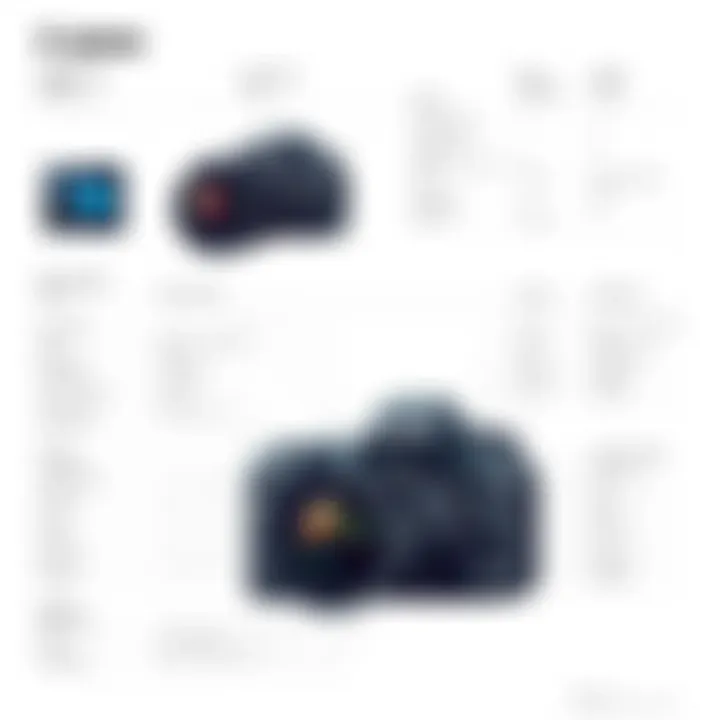
Comparing Canon to Competitors
When venturing into the vast realm of photography, understanding how Canon stacks up against its competitors is crucial. Choosing a camera isn't just about specifications; it’s about the entire package. This means considering the nuances of how Canon measures up to other leading brands in the industry. Anyone who’s serious about photography will find they have preferences. Whether it’s the feel of the camera in hand, the menu layout, or even the color science, what's right for one user may not suit another.
A comprehensive comparative analysis aids in discerning whether Canon's reputation for quality holds up against the likes of Nikon or Sony. It’s not just about the numbers, but the experience behind the lens. Factors like autofocus performance, lens availability, and customer support play a significant role in decision-making. This discussion ensures that potential buyers understand not only the strengths but also where Canon might lag behind in certain aspects, allowing for a more informed choice.
Canon vs. Nikon
Both Canon and Nikon are heavyweights in the DSLR market, with decades of experience to back their products. When dissecting the competition between these two giants, some key aspects emerge:
- Image Quality: Canon’s color science often tends to produce warmer, more vibrant images, which many photographers lean towards for portraiture. Nikon, however, tends to favor cooler tones, appealing to those capturing landscapes or more subdued aesthetics.
- Lenses and Accessories: Canon has a more extensive range of lenses available, particularly for their L-series. These lenses are known for their exceptional optical quality and build. Nikon has been catching up, but some users still find Canon's selection to be more diverse.
- Ergonomics: Handling is subjective, but many photographers report that Canon feels more intuitive, with a layout that aligns well with shooting needs. However, others might prefer Nikon's more logical control arrangement.
"In the end, it's about comfort and personal preference. What works for one photographer might feel all wrong for another."
- Video Features: With the growing market for video, Canon's Dual Pixel autofocus system gives it an edge over Nikon. This system is often cited for its smooth focus transitions, making it a favorite for videographers.
Canon vs. Sony
As the world shifts further towards mirrorless systems, Sony has made a significant dent in Canon’s audience. Here’s how they compare:
- Innovative Technology: Sony often beats Canon to the punch with advanced technology like in-body stabilization and faster burst shooting. The A7 series has garnered praise for its professional-grade video capabilities. Canon, however, is catching up with their EOS R series and offers unique features like the fully articulating touchscreen, appealing to vlogging creators.
- Battery Life: Historically, Canon DSLRs are noted for long battery life, a clear advantage for any shoot. Sony cameras, particularly the mirrorless range, require more frequent changes, as their electronic viewfinders and live displays draw power quickly.
- User Interface: Canon typically has a reputation for a more user-friendly interface, particularly for entry-level photographers. Many find the menu system easier to navigate compared to Sony’s somewhat complex settings that can overwhelm the uninitiated.
- Lens Ecosystem: Canon may have an edge in lenses, especially with unique options like the RF mount lenses, which are made specifically for their mirrorless line. Sony, however, has an abundance of third-party lens options that provide flexibility but can vary widely in quality.
In summary, comparing Canon to its competitors, both Nikon and Sony, reveals distinct advantages and trade-offs. Understanding these variances adds depth to the decision-making process, ensuring that photographers choose a system that aligns with their individual preferences and needs.
User Experience and Community Feedback
Understanding the user experience and the feedback from the community is of utmost importance for anyone looking to invest in Canon cameras. This section delves into how real users interact with Canon's offerings, presenting insights that are invaluable for both prospective buyers and those looking to fully leverage their equipment. As the saying goes, "you can’t judge a book by its cover," and this holds true for cameras; often, specifications on paper don’t paint the whole picture of how a camera performs in real-world scenarios.
Online Forums and Discussions
Online forums and photography discussion boards serve as treasure troves for insights into Canon cameras. Websites like Reddit or specialized photography forums often buzz with reviews, tips, and personal experiences from users of all levels, from beginners to seasoned professionals. Here, users share their experiences, troubleshoot issues, and celebrate their photography journeys.
- Benefits of Engagement: Being part of these discussions provides potential buyers with diverse perspectives. Feedback about ergonomics, user interface, and actual image performance can be gleaned from firsthand accounts.
- Considerations with User-Generated Content: However, one must tread carefully. Not all opinions are created equal; some might be driven by brand loyalty or specific circumstances that don’t represent the broader user base.
These forums allow prospective buyers to ask questions and get responses that are often more detailed than manufacturer brochures or advertisements. Insight into how well a camera holds up under stress or real-world conditions can influence a buying decision significantly.
Real-World Photography Experiences
Nothing speaks louder than actual photographs taken with Canon cameras, reflecting true performance in varied environments. Social platforms like Instagram and Facebook showcase a plethora of images from every corner of the world, demonstrating what Canon cameras are truly capable of. Users share their galleries, discuss settings, and reveal post-processing techniques that are instrumental to their photography creations.
- Diverse Use Cases: Whether it's wildlife photography taken in the rainforests of Costa Rica or urban landscapes snapped in the bustling streets of Tokyo, these experiences contextualize the specs provided by Canon. Users often discuss how certain camera models handle low-light situations or fast-moving subjects, aspects that may not be highlighted as much in official reviews.
- Community Challenges: Additionally, real-world experiences often bring to light the challenges users face, such as limitations of autofocus in specific scenarios or battery life concerns in an all-day shoot. This level of detail offers a more nuanced understanding of how a camera might perform in the user’s specific shooting conditions.
In summary, the user experience and community feedback encapsulate crucial feedback loops between Canon and its camera users. They provide a living, evolving understanding of how these machines actually perform in the hands of their users. This information can pivot a decision from ambiguous to informed, marrying the technical specifications with the visceral experiences reported by those who have used them in the field.
Future Trends in Canon Technology
As we gaze into the crystal ball of camera technology, one can't help but notice the rapid shifts and advancements occurring within Canon's lineup. Understanding the future trends in Canon technology isn’t just a passing interest; it’s crucial for anyone considering investing in a camera or simply keeping abreast of the evolving photography landscape. In this section, we'll explore key areas where Canon is channeling its resources and creativity, and how these advancements will affect both enthusiasts and professionals alike.
Upcoming Releases and Innovations
Canon's approach to innovation is often characterized by a mix of keeping the traditional roots that photographers trust, while also leaping forward into new technology. Some of the buzz right now is around the anticipated models in the EOS R series, which have already stirred excitement within the photography community.
For instance, recent whispers suggest that a new full-frame mirrorless camera is on the horizon, potentially aimed at professionals seeking unrivaled performance. Here are a few anticipated features:
- Improved Autofocus Systems: With Canon's Dual Pixel CMOS AF technology, expectations are for even faster and more accurate autofocus. Photographers will likely appreciate the ability to track moving subjects with greater precision.
- Enhanced Video Capabilities: Canon is making strides in the video arena as well. Many professionals are looking forward to models that can shoot in 8K resolution and offer advanced features like log profiles for color grading, catering to filmmakers and content creators.
- Sleeker Designs and Better Ergonomics: There is a strong push for lighter, more ergonomic designs that can ease the burdens of long shooting sessions. A camera that feels good in hand contributes significantly to the overall user experience.
All these factors suggest Canon is not standing still; rather, they are crafting a future that embraces both ease of use and cutting-edge technology.
The Shift Towards Hybrid Cameras
The lines between photography and videography are continually blurring. Canon has recognized this trend and is responding with the development of hybrid cameras that excel in both stills and video recording.
Hybrid cameras appeal to a broad array of users, from vloggers to professional photographers who want to capture high-quality video alongside stunning photographs. Here are some aspects to consider regarding this shift:
- Dual Performance: The idea is simple yet profound: users want a camera that does it all. Expect features like exceptional low-light performance, high frame rates for video, and robust in-camera stabilization.
- Adaptation to User Demands: With the rise of content creators on platforms like YouTube and social media, Canon seems poised to meet the demands of this demographic by offering versatile hybrid solutions.
- Integration of Connectivity: As more photographers and videographers share their work online, cameras need to evolve with built-in capabilities to stream or upload content directly to the web without needing extensive post-processing.
"The future of photography is not just capturing moments; it’s about expressing them across multiple platforms."
Ending and Final Thoughts
Wrapping up the extensive review of Canon's camera lineup, it's evident that this brand holds a crucial place in the photography world. This article has journeyed through different categories of Canon's offerings, from entry-level DSLRs to specialized professional equipment. Each type of camera has been evaluated on its features, performance, and user applicability. The diversity in models ensures there's something for everyone, be it novice photographers or seasoned professionals.
When summarizing Canon's position in the market, a few elements stand out. For one, their long-standing reputation for manufacturing reliable, high-quality cameras has not faded with time. The brand's dedication to innovation is apparent through its regular introductions of cutting-edge technology tailored for modern photography demands. Furthermore, the robust ecosystem of lenses and accessories computed with Canon cameras enhances overall user experience, solidifying their prestige in this competitive industry.
Summarizing Canon's Position in the Market
Canon remains a formidable player in the camera space, despite the rise of mirrorless alternatives and smartphone photography. From the well-loved Canon EOS Rebel series aimed at beginners to high-performance models like the EOS-1D X Mark III for elite professionals, Canon's product range speaks volumes about its adaptability. Their investments in research and development are evident in the increasingly sophisticated sensor technology, reliable autofocus systems, and video recording capabilities.
Another noteworthy point is the loyal community built around Canon cameras. Many photographers, both amateur and professional, rave about their experiences on forums and social media platforms, highlighting the ease of use and extensive learning resources available. With a history rooted in quality and a commitment to satisfying users' needs, Canon's market position remains strong.
Recommendations Based on User Needs
Ultimately, selecting the right camera hinges considerably on specific user requirements. For those just starting in photography, the Canon EOS Rebel line serves as an excellent entry point. With intuitive controls and affordability, it equips budding photographers without overwhelming them with complexity.
In contrast, for users who wish to explore more advanced photographic techniques, the Canon EOS 90D provides a robust feature set, blending ease of use with professional-grade specifications. For professionals, investing in the EOS-1D X Mark III opens doors to unparalleled performance, catering to high-stakes environments like sports or wildlife photography.
Given the trend toward hybrid cameras that combine features suited for both photo and video capture, those interested in multimedia production may find the Canon EOS R series aligns well with their needs. The adaptability with EF lenses through an adapter further makes it a brilliant choice for diverse filming and photography scenarios.



